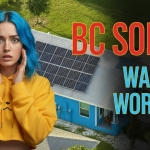
Are Solar Panels Worth It In BC After Greener Homes Loan Is Gone?
October 11, 2025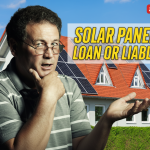
Do solar panels increase home value in Canada
October 15, 2025Is a solar panel installation in Kelowna still a smart financial move without the big federal grants? Let’s run the numbers. The answer might surprise you. The short answer is yes, it can still be a solid investment. But the “how” and “why” depend entirely on the numbers, not just on feeling good about clean energy.
My name is Vitaliy Lano, and I run SolarEnergies.ca. With over a decade in home improvement, I’ve seen homeowners make great decisions and some not-so-great ones. My goal is to give you the straight-up data so you can see if a solar project in Kelowna fits your budget and your goals. We’ll look at the real costs, the actual available rebates, and what you can expect to save.
Is Solar Panel Installation Worth it in Kelowna, BC?
Kelowna is one of the top cities in Canada for solar panels, and it’s not just a feeling; the data backs it up. The city gets an average of 2,000+ hours of sunshine per year. That’s a lot of free fuel hitting your roof.
The viability of a solar panel installation hinges on a few key factors:
- High Sunshine: Kelowna has it. More sun means more power generation.
- Electricity Costs: FortisBC electricity rates aren’t the highest in the country, but they are steadily rising. Generating your own power provides a hedge against future price hikes.
- Incentives: While the big federal grant is closed, you can find a complete guide to solar panels in BC and the incentives that remain.
- Net Metering Program: This is the crucial piece. Both FortisBC’s and BC Hydro’s programs let you “bank” excess energy credits in the summer and use them in the winter.
- 0% Down Financing: Some companies can offer financing options that allow you to install a system with no money down and a monthly payment that is often less than your current average electricity bill. This can make the investment cash-flow positive from day one.
The verdict? For many Kelowna homeowners, the long-term savings outweigh the initial installation costs, leading to a reasonable payback period.
What is the Cost of Solar Panel Installation in Kelowna?
Let’s talk numbers. The complete cost of a solar system for a home is measured in dollars per watt. In the Okanagan, you can expect the cost to be somewhere between $2.50 to $3.50 per watt installed. This price includes panels, inverters, racking, permits, and labour.
The size of the system you need depends on your electricity consumption. Here are some typical scenarios for homes in Kelowna. The final price depends on factors like using standard vs. premium high-efficiency panels or the complexity of your roof structure:
| Home Size | Average Annual Usage (kWh) | System Size (kW) | Estimated Cost (Before Incentives) |
|---|---|---|---|
| Smaller | 6,000 kWh | 5 kW | $12,500 – $17,500 |
| Medium | 10,000 kWh | 8 kW | $20,000 – $28,000 |
| Larger | 15,000 kWh | 12 kW | $30,000 – $42,000 |
Tip for Budgeting: These are ballpark figures. The final cost depends on the equipment you choose (here are some of the best solar panels in Canada), the complexity of your roof, and the specific solar company. Always get at least three detailed quotes.
What Rebates and Incentives are Available for Solar Energy in BC?
This is where things can get confusing, especially in Kelowna. The city is unique because its electricity is supplied by two different companies: FortisBC serves about 60-70% of residents, while BC Hydro covers the remaining 30-40%. Your available programs depend on which company sends you a bill. Additionally, each company offers distinct incentives and programs aimed at promoting energy efficiency and sustainability. For example, the BC Hydro 2025 electrification plan outlines significant investments in infrastructure and renewable energy initiatives that may benefit local residents. It’s essential to check which programs are available through your specific provider to fully take advantage of these offerings.
The Big One That’s Gone: Canada Greener Homes
First, let’s clear this up. The Canada Greener Homes Grant and Loan program is gone and is no longer accepting new applicants. If you didn’t apply before the February 2024 deadline, this federal money is off the table. Any mention of a “$10k grant” was typically a combination of this now-closed federal grant and other provincial offers.
What’s Actually Available in Kelowna?
For All Homeowners in BC
- PST Exemption: This is a straightforward benefit. The BC government has a provincial sales tax (PST) exemption on solar panel equipment. On a typical medium-sized system, the hardware might cost around $15,000. The 7% PST exemption saves you over $1,000 instantly.
If You’re a FortisBC Customer
- FortisBC Net Metering Program: This is the most valuable program for making solar work financially. It allows you to send excess power to the grid for credits, which you then use during months when your system produces less.
- CleanBC Rebates: FortisBC partners with the CleanBC Better Homes program. While there aren’t typically large direct rebates just for solar, adding a solar system can sometimes help you qualify for bonus rebates when combined with other upgrades like installing a heat pump. Check the CleanBC website for the latest offers.
If You’re a BC Hydro Customer
- BC Hydro Net Metering Program: BC Hydro’s program works almost identically to FortisBC’s. You get full retail credit for the energy you send to the grid, helping to zero out your annual electricity bill.
- CleanBC & BC Hydro Rebates: BC Hydro also partners with CleanBC. Again, large stand-alone solar rebates are not the focus. The programs are geared towards whole-home efficiency. The rumored “$10k rebate” is not a single grant for solar. It refers to the maximum amount you could get by stacking multiple rebates for things like insulation, windows, and heat pumps, which often included the old federal grant. You should still check the CleanBC website to see what current rebates you might be eligible for.
How Does Net Metering Work in Kelowna?
Whether you are with FortisBC or BC Hydro, the net metering concept in Canada is the same and is the key to making solar a success in the Okanagan. Here’s how it works in plain English:
- Summer Months: Your solar panels will likely produce more electricity than your home uses, especially during long Okanagan summer days.
- Exporting Power: This excess power is sent back to the grid. Your utility (FortisBC or BC Hydro) gives you a credit for every kilowatt-hour (kWh) you send them.
- Winter Months: Your panels produce less power, and you’ll need to draw electricity from the grid. You use up the credits you banked over the summer to pay for this.
- Annual True-Up: Once a year, on your anniversary date, the utility settles your account. If you have any leftover credits, they pay you out at a wholesale rate, which is lower than the retail rate. The goal is to size your system to match your annual usage, not to become a major power seller.
This program effectively lets you balance your energy production over the entire year. You get full retail value for the excess power you generate in the summer, which directly offsets the cost of the power you use from the grid in the winter.
What are the Steps Involved in a Solar Project Installation?
Going from curiosity to a functioning solar system involves a clear process.
- Consultation & Design: A solar company assesses your home’s roof, shading, and your past electricity bills. They design a custom solar installation tailored to your specific energy needs.
- Quoting & Financing: You receive a detailed quote. This is when you discuss payment options. Now that the federal loan is gone, it’s important to understand how to finance your solar panels. Some companies offer 0% down plans, which can remove the upfront cost barrier.
- Permits & Paperwork: The solar contractor handles all the permits with the City of Kelowna and the net metering application with your utility (FortisBC or BC Hydro).
- Installation: The installation team mounts the racking, attaches the solar panels, and installs the inverters. This usually takes 2-4 days for a residential solar system.
- Inspection: A municipal inspector and a utility representative will inspect the system to ensure it’s safe and up to code.
- Commissioning: Once approved, your system is turned on. You are now generating your own clean energy.
Choosing Solar: Selecting the Right Solar Company in Kelowna
The company you choose is just as important as the panels they install. A poor installation can cause roof leaks and underperformance, wiping out your potential savings.
How to Find Reliable Solar Experts in the Okanagan
- Look for Local Experience: A company familiar with Kelowna’s specific weather patterns and permitting process is a huge plus.
- Check Certifications: Look for installers with certifications like NABCEP or from SolarBC. It shows a commitment to industry standards.
- Read Reviews: Don’t just look at the company website. Check Google, HomeStars, and other third-party sites. Look for patterns in feedback from homeowners across BC.
- Get Multiple Quotes: I can’t stress this enough. It helps you compare costs and get a feel for the different companies.
Questions to Ask a Solar Provider
Make sure you have a good list of questions to ask solar companies before you sign anything. Key questions include:
- What brand of solar panels and inverters do you use? Why?
- What warranties are included for the equipment and for your workmanship?
- Can you provide references from other jobs in the Okanagan?
- Who handles the permitting and utility application?
- What is the estimated timeline from signing the contract to the final installation?
I once had a client in West Kelowna who went with a low-ball offer from an out-of-province company—a classic example of a potential solar panel scam. They waited six months for the installation, and when a panel failed a year later, they had a terrible time getting warranty service. A local, trusted solar contractor is worth a small premium.
Maximize Your Solar Energy: Generation Estimates
So, how much power can you actually generate? Using official government modeling tools for a typical south-facing roof in Kelowna, here are some realistic estimates.
| System Size (kW) | Estimated Annual Generation (kWh) | Estimated Annual Savings (@ $0.15/kWh) |
|---|---|---|
| 5 kW (Smaller) | 5,500 – 6,500 kWh | $825 – $975 |
| 8 kW (Medium) | 8,800 – 10,400 kWh | $1,320 – $1,560 |
| 12 kW (Larger) | 13,200 – 15,600 kWh | $1,980 – $2,340 |
Tip for Roof Condition: Before you even think about panels, look at your roof. The average lifespan of asphalt shingles in the Okanagan is about 20-25 years due to the intense sun and winter snow. If your roof has less than 10 years of life left, replace it before installing solar. Paying to remove and reinstall a solar array down the road is expensive.
Commercial Solar for Businesses in Kelowna
The principles are the same for commercial solar systems, just scaled up. Businesses have a few extra advantages:
- Higher Electricity Rates: Commercial power rates are often higher, making the return on investment faster.
- Large Roof Space: Warehouses and retail buildings are perfect for large solar arrays.
- Depreciation: Business owners can depreciate the asset, creating tax advantages.
From churches going solar in BC to large farms, the business case for solar is strong. A solar power system can significantly reduce operating costs and provide a visible commitment to sustainability that customers appreciate.
Final Thoughts: Control Your Energy Future
Switching to solar in Kelowna is a major decision. The loss of the Greener Homes Grant stings, but it doesn’t kill the viability of solar power in one of Canada’s sunniest regions.
The combination of the PST exemption and an excellent net metering program means you can still see a reasonable payback period. After that, the electricity is virtually free for the life of the system, which can be over 25 years.
It gives you control over your energy costs in a world where prices only seem to go up. If you’re considering it, the next step is simple: start the conversation. Talk to a few reputable, experienced solar installers and see what the real numbers look like for your home.

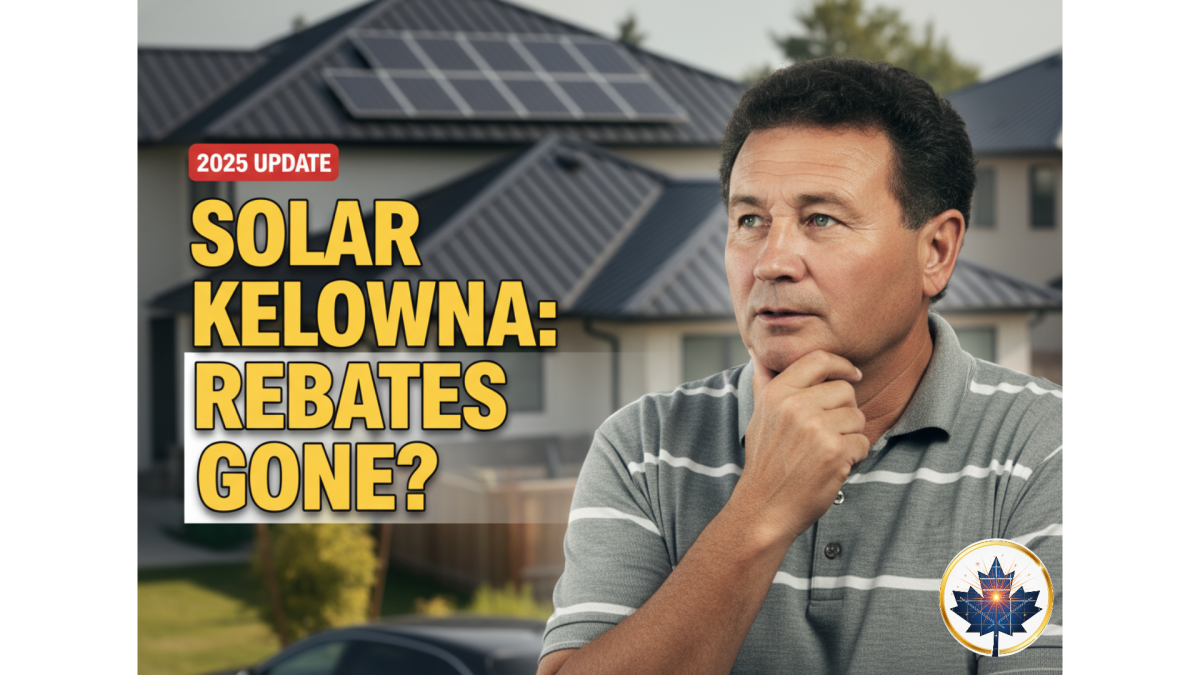
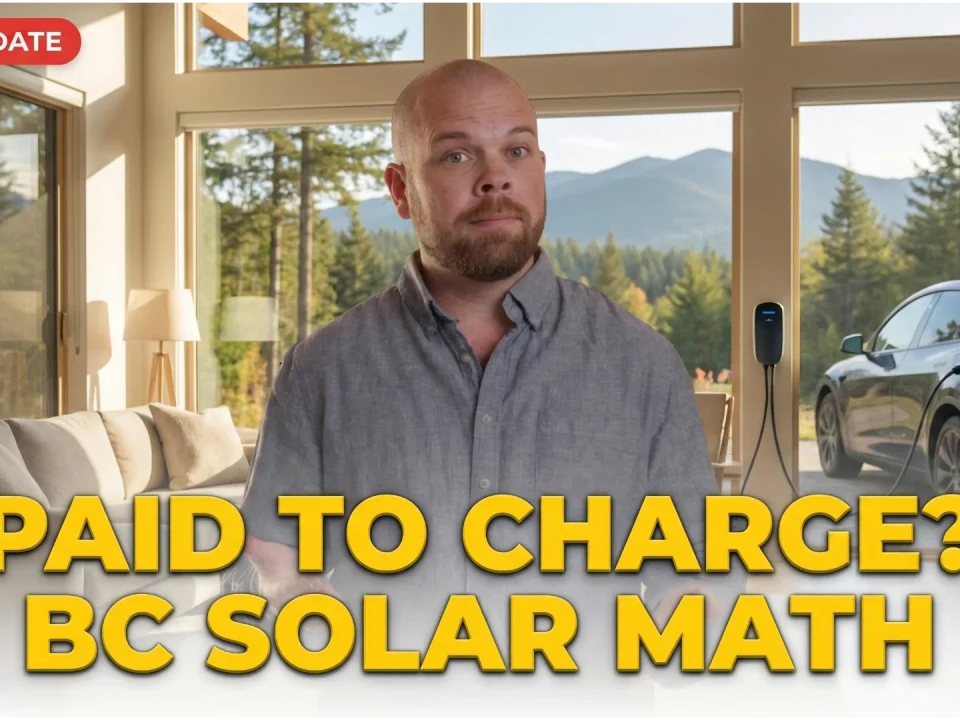
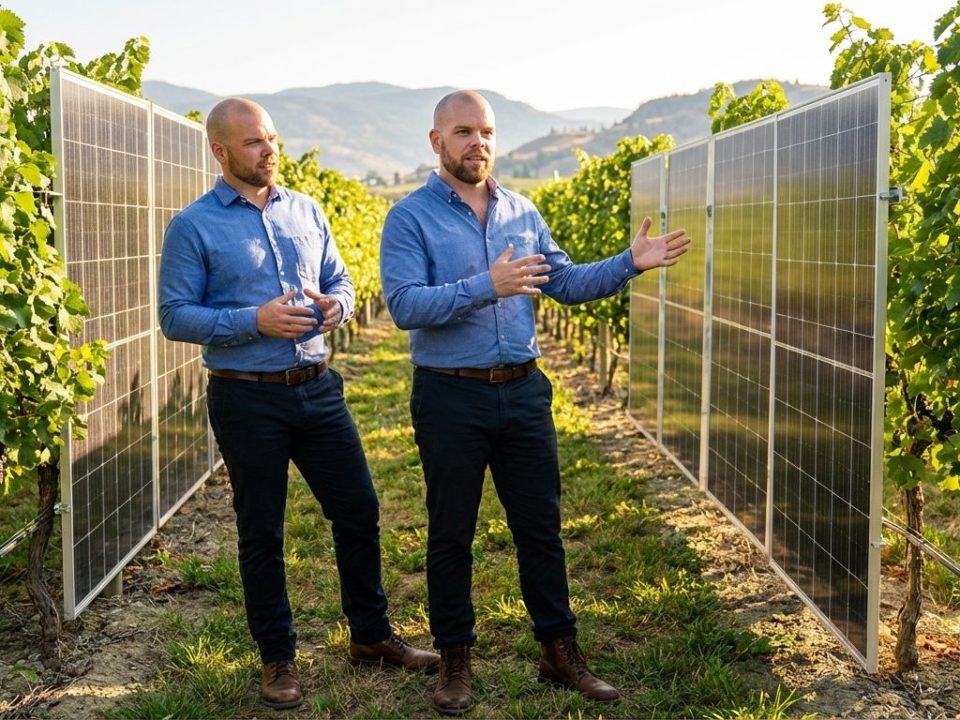

6 Comments
I get the whole solar panel hype in Kelowna, but isnt the weather kinda unpredictable? How efficient are these panels in cloudy conditions? Plus, are the rebates even significant enough to offset the installation cost?
Interesting read, but arent we forgetting the snow factor? How effective are these panels in Kelownas winters? Also, isnt the upfront cost still quite steep despite rebates? Just playing devils advocate here.
Efficiency varies, but even in winter, solar panels arent dormant. Its an investment, not a gamble.
Cloudy days dont obliterate solar power. Proper planning and storage tackle inconsistency. #EfficiencyOverCost #ThinkGreen